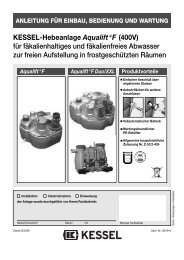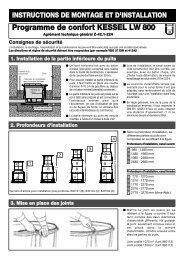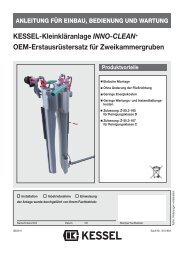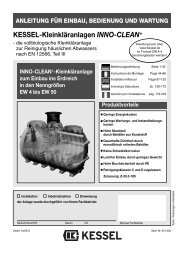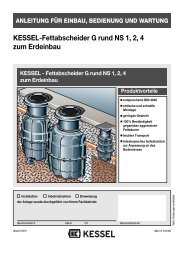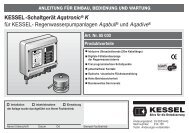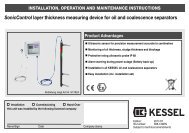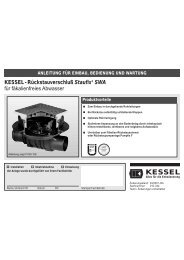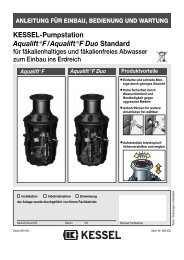KESSEL-Kleinkläranlagen INNO-CLEAN® - Kessel Design
KESSEL-Kleinkläranlagen INNO-CLEAN® - Kessel Design
KESSEL-Kleinkläranlagen INNO-CLEAN® - Kessel Design
You also want an ePaper? Increase the reach of your titles
YUMPU automatically turns print PDFs into web optimized ePapers that Google loves.
6. Operation and disposal<br />
6.1 Operation<br />
After commissioning of the plant, an active activated sludge<br />
layer with microorganisms forms in the aeration chamber<br />
after 3-6 months. It is not necessary to feed any microorganisms<br />
to this plant. We however consider a feeding of activated<br />
sludge from the nearest sewage treatment plant reasonable.<br />
Important: Only feed activated sludge into the aeration<br />
chamber!<br />
To ensure a smooth operation, maintenance intervals have<br />
to be strictly adhered to. The timely emptying of the preliminary<br />
sedimentation chamber must be ensured.<br />
The operation of the small sewage treatment plant is fully<br />
automatic. In detail, there are three phases, the "normal",<br />
"economy" and "holiday" phase. These differ with regard to<br />
their aeration time and quantity. The actual purification takes<br />
place during the normal phase (6 hours).<br />
In case of an inadequate feeding of the plant (insufficient sewage<br />
inflow), it will automatically switch to the "economy<br />
phase" (2 hours). In this phase, the aeration time is reduced<br />
to the lower sewage quantity, to prevent "starving out" the<br />
adapted microorganisms. If the plant remains in the "economy<br />
phase" for a longer period of time (8 hours), it automatically<br />
switches to the "holiday phase".<br />
The "holiday phase" is characterised by an even lower supply<br />
of oxygen. Supplementary to that, a defined amount of<br />
sludge is conveyed from the aeration chamber into the preliminary<br />
sedimentation at the end of the holiday phase. This<br />
makes it possible to supply a certain amount of nutrients to<br />
the aeration phase during the next feeding. This contributes<br />
towards the preservation of the biology during a prolonged<br />
standstill.<br />
As soon as a sufficient amount of water is available in the<br />
preliminary sedimentation chamber so that the floater is<br />
switched on during the subsequent feeding, the plant will<br />
automatically switch back to the normal phase.<br />
This adaptation to different sewage quantities is automatically<br />
controlled by the control unit. The corresponding phase<br />
is indicated on the control unit. A general overview of the<br />
pertinent phases and cycles is provided in chapter 2.5.<br />
Heeding the following recommendations will help you avoid<br />
unnecessary costs of repair and increase your plant's service<br />
life:<br />
• The plant must remain switched on all the time, even if you<br />
are away on holiday.<br />
• External water, such as rain, ground, swimming pool or fish<br />
tank water may not be discharged into the plant.<br />
• In the case of household detergents please pay attention<br />
that these do not exhibit any acidic or alkaline reactions.<br />
We recommend the use of biodegradable detergents and<br />
washing agents.<br />
• It must be possible to open the plant's covers.<br />
• Ensure that the plant is regularly serviced by a specialised<br />
firm.<br />
• It is only necessary to have the preliminary sedimentation<br />
desludged regularly (approx. every 12-24 months) by a<br />
waste disposal contractor! After consultation with the responsible<br />
water authorities and conclusion of a maintenance<br />
contract, this can however possibly also take place<br />
in line with demand.<br />
Note: If the plant is taken out of operation, it must be ensured<br />
that it continues to remain filled.<br />
It is imperative to note the following:<br />
You can continue to use any detergent and washing<br />
agent, but please adhere to the manufacturers' dosing instructions!<br />
It is also possible to use various drain cleaners, provided<br />
the dosing according to manufacturers' specifications is<br />
adhered to.<br />
However, every time these detergents are discharged into<br />
the plant, a number of bacteria die off. If possible, please<br />
make use of biodegradable detergents and dispense<br />
with the use of drain cleaners (see 6.3).<br />
6.2 Self-inspection by the operator<br />
As operator of the sewage treatment plant it is your obligation<br />
vis-à-vis the water authority to ensure a smooth operation<br />
of the plant. Malfunctions on small biological sewage<br />
treatment plants have a negative effect on the drainage quality<br />
of the purified water. These must therefore be detected<br />
without delay and rectified by yourself or by a qualified maintenance<br />
firm. So as to keep a record of your self-inspections<br />
you are obliged to keep an operations diary. At the end of<br />
this manual, you will find a master copy that contains all the<br />
necessary specifications.<br />
The water authority may demand to look at this operations<br />
diary. In detail, you are requested to regularly carry out the<br />
following inspections:<br />
Monthly inspections<br />
• At the control: Carrying forward the operating times on the<br />
display into the operations diary<br />
• At the preliminary sedimentation: inspection of the floating<br />
sludge on the water surface. If necessary, this must be<br />
drawn off or broken up with clear water. No sludge may<br />
enter the aeration chamber in an uncontrolled manner.<br />
The sludge must be disposed off at the latest when 70%<br />
of the intake capacity has been reached. Measuring the<br />
thickness of the sludge layer is carried out similar to measuring<br />
the oil level on motorcars. Use a long stick or similar<br />
implement. This is plunged into the preliminary sedimentation<br />
chamber down to the bottom of the tank. The<br />
measuring tool is then removed from the tank and the<br />
sludge layer can be measured. An exact measurement can<br />
be carried out by qualified personnel.<br />
• At the aeration chamber: visual inspection of the draining<br />
water for clearness<br />
• Visual inspection of the mixing process and the input of air<br />
bubbles<br />
110



